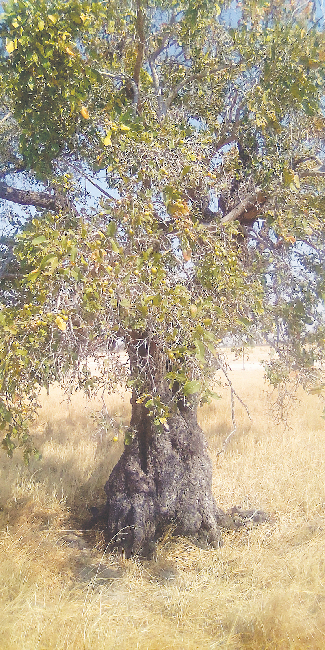JACKALBERRIES, fruits of one of Namibia’s indigenous trees of many uses, are ripe and the tree is now at its peak. People and animals are enjoying its sweet, fleshy fruits in many rural areas.
The jackalberry tree is an ever-green tree that grows to 10-25 metres tall, with a bare, fluted trunk and a dense spreading crown.
Jackalberries are sold at many open markets at towns such as Oshakati, Ondangwa, Outapi, Eenhana and even in the capital city, Windhoek.
Junias Pasckalis (72), from Otuwala village in the Okatana constituency in Oshana region, said the jackalberries are very sweet and many people in northern Namibia like them.
“That is why you see people selling these fruits in many parts of the country,” he said.
Every morning, people, especially children in the villages, rush to jackalberry trees to pick the sweet berries for domestic consumption and for sale.
The people share the berries with animals, such as jackals, goats and birds.
Jackalberry seeds are commonly found in the dung of jackals and that is where the tree got its name from.
“The jackalberry tree is very important to us because it provides us with its sweet fruit. It also provides good shade and firewood,” Pasckalis said.
In recent years, some Namibians, mainly women in rural areas, have been trained on how to make products such as jam, juice and cake from indigenous, underutilised fruits and vegetables such as jackalberries.
Blasius Elago (66), a resident of Oniimwandi village in the in Oshana region, said the tree is also home to the southern ground hornbill, one of the two species of ground hornbill found solely within Africa.
The hornbills live in the natural holes of the jackalberry tree.
“When we were growing up, we used to see these huge birds getting into the natural holes on these trees. We were also told that snakes, such as the black mamba, live in jackalberry trees,” Elago added
The southern hornbill is the largest species of the bird worldwide.
In northern Namibia, the jackalberry tree is locally known as omwandi and its fruits, oonyandi. The scientific name of the tree is Diospyros mespiliformis and it has many uses.
Namibian botanist Barbara Curtis told The Namibian that besides producing the berries, the tree is also of medicinal value. For example, an infusion made from its bark can treat bruises she said.
Generally, she said, the tree is very important to people’s livelihoods and for animals.
Curtis added that the tree’s twigs can also be chewed to clean one’s teeth. Furthermore, its leaves are used for traditional medicine, in brewing traditional alcohol and are also browsed by game animals.
“It often grows near riverbeds and, therefore, it stabilises their banks. I am very happy that you are bringing this important tree to the public,” she said.
According to the 1999 Sasol’s First Field Guide to Trees of Southern Africa, the jackalberry tree is a protected species.
According to the book, butterflies breed on this tree, while wood is used for all-purpose timber, dug-out canoes and stamping blocks.
Stay informed with The Namibian – your source for credible journalism. Get in-depth reporting and opinions for
only N$85 a month. Invest in journalism, invest in democracy –
Subscribe Now!






